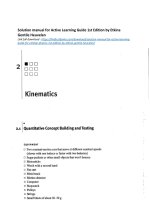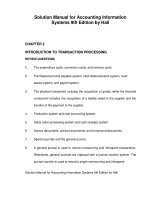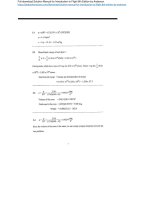Solution manual for personal finance second canadian edition 2nd edition by madura
Bạn đang xem bản rút gọn của tài liệu. Xem và tải ngay bản đầy đủ của tài liệu tại đây (154.44 KB, 6 trang )
INSTRUCTOR’S SOLUTIONS &
RESOURCE MANUAL
Prepared by
Hardeep S. Gill
NAIT
PERSONAL FINANCE
Second Canadian Edition
Jeff Madura
Florida Atlantic University
Hardeep S. Gill
NAIT
Toronto
Copyright © 2012 Pearson Canada Inc., Toronto, Ontario. All rights reserved. This work is protected by Canadian
copyright laws and is provided solely for the use of instructors in teaching their courses and assessing student
learning. Dissemination or sale of any part of this work (including on the Internet) will destroy the integrity of the
work and is not permitted. The copyright holder grants permission to instructors who have adopted Madura, Gill,
Personal Finance, Second Canadian Edition to post this material online only if the use of the website is restricted by
access codes to students in the instructor’s class that is using the textbook and provided the reproduced material bears
this copyright notice.
From />
Contents
Overview
................................................................................................................................................. iii
Introduction
................................................................................................................................................. iv
Chapter 1
Overview of a Financial Plan...................................................................................................1
Chapter 2
Applying Time Value Concepts ............................................................................................10
Chapter 3
Planning with Personal Financial Statements.......................................................................18
Chapter 4
Using Tax Concepts for Planning..........................................................................................26
Chapter 5
Banking Services and Managing Your Money.....................................................................39
Chapter 6
Assessing, Managing, and Securing Your Credit.................................................................47
Chapter 7
Personal Loans........................................................................................................................58
Chapter 8
Purchasing and Financing a Home ........................................................................................66
Chapter 9
Auto and Homeowner’s Insurance ........................................................................................78
Chapter 10
Health and Life Insurance ......................................................................................................86
Chapter 11
Investing Fundamentals ...................................................................................................... 100
Chapter 12
Investing in Stocks .............................................................................................................. 111
Chapter 13
Investing in Bonds............................................................................................................... 123
Chapter 14
Investing in Mutual Funds .................................................................................................. 134
Chapter 15
Retirement Planning ............................................................................................................ 145
Chapter 16
Estate Planning .................................................................................................................... 157
Chapter 17
Integrating the Components of a Financial Plan ............................................................... 167
Copyright © 2012 Pearson Canada Inc.
From />
Overview
The Instructor’s Solutions and Resource Manual has been prepared to offer instructors course-planning
assistance when teaching personal finance. It incorporates several teaching aids customized specifically for
Personal Finance, Canadian Edition, Second Edition, by Jeff Madura and Hardeep Gill.
The manual includes a brief overview of each chapter along with a list of chapter objectives. Answers to
both the end-of-chapter review questions and the financial planning problems are included. Where
possible, details of the calculations for the problems are also included. In some instances, answers may be
slightly different when using tables, calculators, and/or the student CD-ROM.
The manual presents answers for the questions accompanying the two continuing case exercises The
Sampsons (on MyFinanceLab) and Brad MacDonald.
Each chapter includes numerous teaching tips. These tips arose from many years of teaching personal
finance principles in the classroom. The tips are meant to help instructors promote discussion in the
classroom. The tips also address some common misconceptions that students sometimes have about
personal financial planning.
Many thanks go to those at Pearson Canada for their help in preparing and technically checking this
manual.
Copyright © 2012 Pearson Canada Inc.
From />
iii
Introduction
The Instructor’s Solutions and Resource Manual for Personal Finance, Second Canadian Edition, by Jeff
Madura and Hardeep Gill is designed to meet the far-ranging needs of personal finance instructors. In most
schools, a personal finance course is not a required course and therefore will often attract students from
many different backgrounds and colleges who will be taking the course as an elective. This subsequently
creates a challenging teaching environment. Some students may feel overwhelmed by the material, while
others may find it too basic. Having access to a variety of resources, methods, and materials may alleviate
some of these challenges. This introduction describes the many resources this instructor’s solutions and
resource manual contains. We hope it will ease the burden of busy instructors and help them to enhance
their students’ ability to retain the material.
An Overview of Chapter-by-Chapter Resources
This manual provides instructors with much more than the solutions to the end-of-the-chapter exercises.
Each chapter begins with an introduction to the chapter. This introduction is intended to aid the instructor
by offering a brief summary of the topics that will be covered in that chapter. In this way, each instructor
should be better able to determine if only a portion of the topics will be sufficient or if the coverage will be
comprehensive.
In-depth Teaching Suggestions for each chapter include both important topics to be discussed in an
individual chapter and additional assignments that may be helpful to aid the students in learning the
material. Some of the teaching suggestions were created to provide a variety of teaching methods.
Educational research shows that using a variety of teaching methods produces the best results. Thus, the
instructor may choose to implement some of the following methods to vary instruction.
Teams: Many of the suggestions are geared toward the implementation of teams (three to five members
on a team). Of course, team make-up depends on several things, including class size, number of hours in
the course, and whether the course is online or on-site. Students do learn from each other and in a course
such as personal finance, many students will have a variety of educational backgrounds and real-world
experiences. The use of teams allows students to share this knowledge with their peers and has proven to
be very effective.
Community Resources: The use of community resources is another way to provide a variety of learning
experiences. The following is not a comprehensive list, but simply a few suggestions that may be available
in various locales. These professionals will generally be most willing to give a presentation to the class at
no charge. The exposure to professionals with careers dealing with personal financial issues in the “real
world” has proven to provide an invaluable learning experience for students.
Consumer Counseling Service: Credit use and abuse, prevention and management, budgeting.
Banks and Credit Unions: Financial services, home buying and credit, chequing, investing.
CMHC: housing finance options, mortgage loan insurance, information on the housing market in Canada
Insurance Companies: Features of Auto and Property, Health, Disability, Critical Illness, Long-Term
Care, and Life Insurance.
Taxes: Canada Revenue Agency on tax laws, filing, and returns.
Lawyers: Information on wills, estates, and legal issues.
Copyright © 2012 Pearson Canada Inc.
From />
iv
Financial Planners/Advisors: Information on building a financial services business and how to build
meaningful client relationships.
Stockbrokers: Various types of information on a variety of investment issues and types.
Internet: There are many Internet assignments in the book and even more suggestions in the Instructor’s
Solutions and Resource Manual. The Internet is a source of information that will be available to the
students even after the class is finished. The information is generally more up to date than any other source
and everyone today has at least limited access to a computer.
Teaching Personal Finance Online
The unique needs of online courses merit separate mention regarding teaching resources and suggestions.
Teaching suggestions geared to the needs of online courses are included in the materials corresponding to
each chapter. What follows are general suggestions to aid the many instructors who are restructuring their
individual courses so they can be taught an online course.
1. An online course should reflect the same rigour and content as the classroom course demands. This
ensures that students are exposed to the same content and learning experiences, which will help ensure
that the course both meets the prerequisite criteria for upper-level courses and/or transfer. Using a
common syllabus and textbook will diminish perceptions that the courses are different.
2. Teams can also be used in an online course. Since many students take courses online because of
scheduling conflicts with work, etc., it would be beneficial before assigning teams to survey the
students as to the times they are available to work online. This would then do some self-selecting for
the teams.
The cases in the text are useful for team solving. Worksheets with discussion questions are also a good
way to use teams. If the students are self-paced, it is more difficult to implement teams. Thus, it is
important to know the target audience before implementation.
3. Communication is critical in any course and even more so in an online course. The address book is a
valuable asset for an online course. The instructor can send messages to everyone at the same time, or
individually. Information can be disseminated quickly and efficiently. For example, answers to
quizzes and exams can be distributed electronically immediately after the deadline assigned for each.
4. Chat Rooms: This is another way to communicate with students. This can serve as office hours.
Students know when the instructor will be online and can participate or not.
5. Just as instructors teach differently in the classroom, so also will this happen in an online course.
Knowing the audience is critical to the success of any class. Today, even in a conventional classroom,
there is often a mix of traditional and nontraditional students. The nontraditional will often have more
experience in financial matters. It is important, though, to remember that financial expertise is not a
matter of intelligence. It is a skill that is learned and that is why students enroll in a personal finance
course. Even though the nontraditional student may have had financial life experiences, it does not
mean that he or she had the necessary skills to make the best decisions at the time.
6. Assessment instruments may vary in an online course. It is virtually impossible to give an exam over
the Internet and ensure that it has been completed as directed with no outside help. The use of a testing
center is one way to alleviate this problem. The student would, of course, have to go on campus during
Copyright © 2012 Pearson Canada Inc.
From />
v
the semester to complete the exams. This is a problem if the student lives a long distance from the
campus and has enrolled in the Internet course specifically because of this predicament. The use of a
proctor at another institution would be another way to ensure that examinations are secure.
7. Being a self-starter is a critical characteristic for a student to be successful in an online course. It is
helpful to include at least a brief discussion of this in the syllabus. During the semester it would be
advisable to repeat this message, perhaps by e-mail. The student’s success will rely on how
responsible and self-motivated he/she is.
Hardeep Singh Gill
Copyright © 2012 Pearson Canada Inc.
From />
vi









